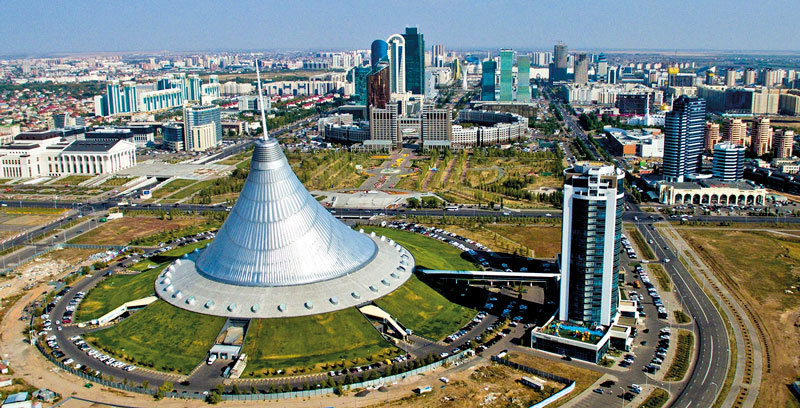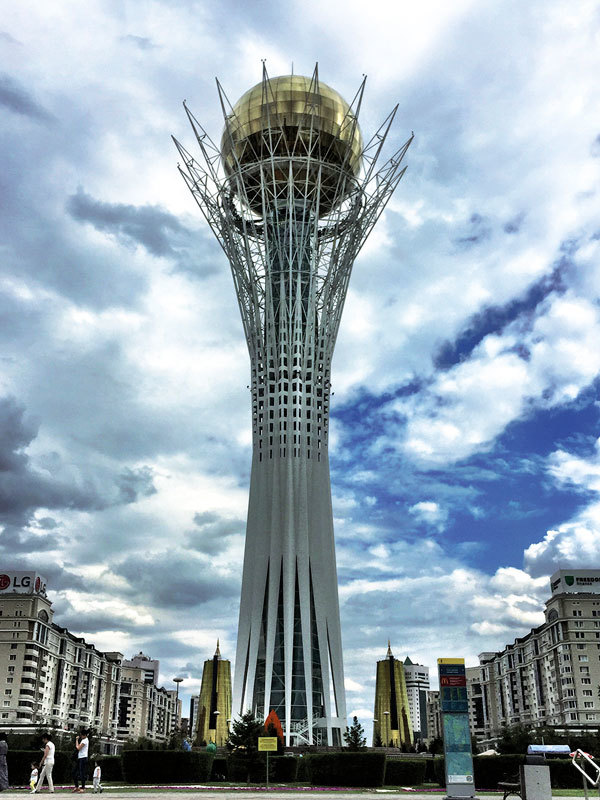Astana: A Modern Metropolis Amidst Nomadic Steppe
Astana, the new capital of Kazakhstan, is the perfect showpiece for the country’s ambitious goal to become the most important hub in Central Asia over the next years.
When I heard the pilot’s announcement that we had begun our final descent to Astana, I excitedly looked out of the window to get a better view of Kazakhstan and its capital city where I was supposed to spend the next couple of days.
But as I looked down, I only saw endless flat steppes - there wasn’t any sign of villages or suburbs, let alone the city itself. Then, as if out of nowhere, Astana came into sight, with high-rise buildings and modern landmarks that I could easily spot from my seat.
Astana is unique in every regard. Located on the banks of Ishim River in the northern part of the country, it became the capital of Kazakhstan in the late 1990s - and is thus one of the youngest capital cities in the world. The decision to move the capital from Almaty to Astana was mainly because of its unique geographical location, at the crossroads of both European and Asian culture.
Over the last two decades, Astana has grown into a modern metropolis, similarly to Canberra in Australia or Brasilia in Brazil, under the watchful eye of Japanese architect Kisho Kurokawa who designed the city’s master plan. Most of the landmarks, however, have been commissioned separately.
Arguably the best known monument in Astana, the Bayterek Tower symbolizes a mythical tree of life and a magic bird of happiness, who has placed his golden egg between the tree’s branches. Made of metal, glass and concrete, Bayterek Tower houses an observation platform on top, where visitors can place their hands in a gilded hand print of Kazakhstan’s president Nursultan Nazarbayev and make a wish.
From Bayterek Tower, it is only a short walk to the Akorda Presidential Palace, which includes a a blue and gold colored dome that is topped with a spire.
Still in the same area, the Khan Shatyr Entertainment Center - a giant transparent tent covering 140,000 square meters - is a state-of-the-art entertainment and shopping venue, that is like a small village in itself: besides the shopping center, it houses a boating river, minigolf and an indoor beach resort.
The Khan Shatyr Entertainment Center was designed by UK architect Norman Foster. It was his second project in Astana after the Palace of Peace and Reconciliation, shaped in the form of a pyramid and built at the time to host the Congress of Leaders of World and Traditional Religions. The top of the palace is decorated with a stained-glass painting of 130 doves representing different nationalities living in Kazakhstan, and the pyramid has since become a symbol of religious tolerance.
Adjacent to the Palace of Peace and Reconciliation is the Hazret Sultan Mosque, which was officially opened in July 2012. The second largest mosque in Central Asia including a dome with the height of 51 meters, it can accommodate thousands of worshipers.
Despite the decidedly modern feel of Astana, the city has not forgotten its roots and history. On the contrary, the people seem to be aware and proud of their heritage. In the shopping centers, one can find many stores selling souvenirs and handmade goods. The art of making national instruments, for instance, influenced the establishment of Kazakh’s musical culture, whereas ceramics and porcelain as well as wooden handicrafts still hold a special place in the country.
The Kazakhs, who are descendants of the Turkic, medieval Mongol and other nomadic tribes of Central Asia, have also established a fine tradition of making leather goods. In the old days, the nomads used leather to make things they needed for everday life, such as whips, saddles and waterskin for keeping horse milk.
For a more detailed history lesson of Astana and Kazakhstan, visitors should head to the exhibition pavilions of the Palace of Independence. Here, they can see traditional outfits and jewelry, weapons and armor of warriors and hand-woven carpets, taking them on a journey into the country’s nomadic past as well as the story of Astana’s transformation from a small settlement in the mid 19th century to the vibrant capital it is today.
In summer time, the weather in Astana is just lovely: it can get quite hot during the day, but most of the time, there is a pleasant breeze (which must be downright mean when it is winter, and Astana is after Ulan Bator, Mongolia indeed the second coldest capital city in the world).
When it comes to food, most of the popular dishes are based on the traditional nomad cuisine that naturally had to be easy to prepare - they mainly consist of meat with additional dairy and bread components. Every traveler should try Kazakhstan’s tasty national dish, Beshbarmark, which means “five fingers” referring to the fact that it is eaten by hand. It consists of finely chopped boiled meat - either horse or lamb - mixed with noodles and a touch of onion sauce.
I may not be the most adventurous traveler, but I find that a city is best discovered by walking: I love to follow little paths off the main roads and catch a glimpse of how ordinary people live. Coming from Jakarta, I highly appreciated the pedestrian-friendly sidewalks and most of all, breathing in clean and fresh air. It was during one of these early evening walks that I discovered a small cafe with a nice outdoor seating area, and I spontaneously decided to take a break and rest my feet for a bit.
The waiter came outside to take my order - unfortunately he didn’t bring a menu and had a rather puzzled look on his face when I asked for an iced coffee in English. But even though we didn’t speak the same language, we managed to find common ground with the help of Google images - and the iced coffee that he served me, complete with a scoop of vanilla ice cream, whipped cream and chocolate sauce on top, turned out to be one of the best I ever had.
It was rather odd to be in a country where I couldn’t get around easily using English, but the Kazakhs were generally friendly and helpful - even if we had to communicate with hand gestures and smiles. There - for me, this already felt rather adventurous.
There is a palpable energy flowing through Astana: it is dynamic without being overbearing. The people feel that things are happening and moving in this city - and so do the visitors.
This article was first published in the August 2017 issue of NOW! Jakarta magazine.



